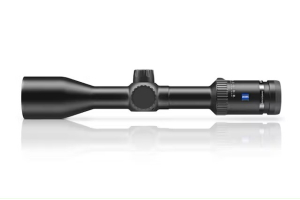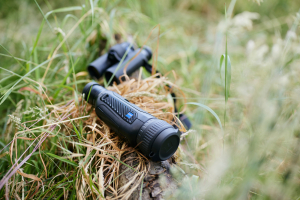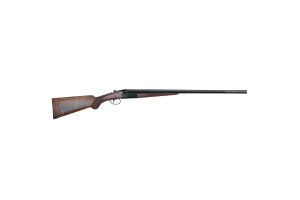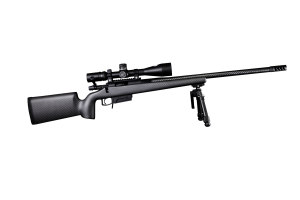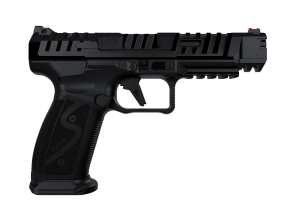
PRODUCT REVIEW - Mauser M98
Johan van Wyk marvels at a rifle put to good use for hunting
War, as detestable a thing as it is, has always been a great inspiration for technical innovation and advancement. War gave us things like penicillin, radar and even computers, all inventions in daily use in modern society. Something else that also came about because of war, or at least the desire to arm the Kaiser’s troops as well as possible in case of the outbreak of conflict, is the German M98 Mauser bolt-action.
The M98 was the brainchild of Peter Paul Mauser, born on June 27, 1838. It was by no means his first invention, though. That honour must go to the Mauser- Norris metallic cartridge rifle from 1867, a design that was advanced for the times but largely ignored by the powers-thatbe in Germany. Success came in 1871 with the adoption of the Model 71 Mauser rifle by the Prussian Ministry of War. Several improved designs followed, but the M93 Mauser created for Spain and chambered for the 7x57 was notable. The M93 featured a sturdy, non-rotating claw extractor as well as a staggered box magazine, two of the later M98’s more notable features. The M94 and M96 Mausers were made for Sweden and chambered in 6.5x55.
In response to a request from the German authorities for a new military rifle design, Paul Mauser presented another offering in September 1897. After months of trials, the rifle was accepted on April 5, 1898. The Gewehr 98 was in business. The M98 action was a marvel. Its bolt consisted of only eight parts and could be disassembled without any tools. The action could easily be re-cocked (in the case of a misfire, for instance) by using the rim of an 8x57 cartridge, the German military cartridge of the day. The rim of the cartridge fitted into a groove milled into the rear of the cocking piece, which could be pulled back to cock the action again. In addition to two opposing locking lugs on either side of the head of the bolt, there was also a third locking lug that fitted into a recess in the receiver in case of a failure of the forward lugs. This feature was new to the M98 action and added an extra measure of safety. Other structures were that the M98 cocked on opening the action and had much reduced lock-time, a noted shortcoming of earlier Mauser actions that affected accuracy.
It also made the action easier to close and therefore faster to cycle and reload. Lastly, Mauser actions were manufactured from good-quality steel that was carefully heat-treated after final machining to make them wear-resistant. The military M98 action’s magazine was tailor-made to house and feed the 8x57 cartridge and the feeding system is what came to be known as controlled round feeding. As the bolt is closed and a cartridge is fed into the chamber, the extractor claw grabs the rim of the cartridge and guides it into the chamber.
After discharge, the bolt is opened and pulled back, and the cartridge is withdrawn until it meets with a fixed-blade ejector located on the left side of the bridge. It is virtually failproof, the most reliable ejector system ever fitted to a bolt-action rifle. The M98’s three-position, flag-type safety catch is another marvel. In the first position it allows the rifle to be fired. Raised upright, or the middle berth, the striker is locked but the bolt can be cycled for unloading or even removed and disassembled. When fully engaged, the safety catch blocks the striker and not merely the trigger. Again, virtually failproof. At the time of its adoption, the Gewehr 98 was the most up-to-date military rifle in the world. It was accurate, reliable and fired a powerful cartridge. While all these virtues were essential and desirable for battlefield use, they made the M98 action eminently suitable for use in the hunting field as well.
This wasn’t lost on Mauser themselves either, and from about 1900, sporting rifles on M98 actions were available in chamberings such as the 8x57 and 7x57. To set the M98 actions destined for sporting rifles apart, they differed from the millions of military actions being manufactured in several aspects. Bolt-handle knobs were pear-shaped instead of rounded as on military actions, cocking pieces were longer, standard of manufacture was higher and they were available in various lengths to suit different cartridges. Later, provision was even made for telescope mounting.
Mauser cast their net even wider than merely offering sporting rifles, though, and in 1898, John Rigby & Co. of London was appointed as Mauser’s agents in the United Kingdom. This move gave Rigby the exclusive right to import and sell all Mauser-made actions, barrelled actions and rifles in Britain and its various colonies.
The affiliation with Rigby would bear more fruit for Mauser than mere sales. Rigby introduced their .400/350 Nitro Express cartridge in 1899 for use in singleshot and double rifles. The .400/350 was a long, rimmed cartridge that fired a 310gr bullet at 2100fps. It quickly gained an excellent reputation in India and Africa, so Rigby soon asked the Mauser engineers if they could make an M98 action that could handle the .400/350 cartridge. Mauser adapted their earlier Siamese Mauser action that was designed for use with a rimmed cartridge and fitted with a special, sloped magazine box to allow proper feeding. They also lengthened the action by approximately a quarter of an inch. The Magnum Mauser action, as the new model was called, made a host of new developments possible.
Mauser developed a slightly shorter version of the standard M98 action for the 7x57 cartridge. This was used not only for sporting rifles but for military use as well and a great many were manufactured for countries such as Peru. Just like they did with the Magnum Mauser and the .400/350, Mauser adapted the intermediate- length action for Rigby for use with the .303 British by fitting the action with a sloped magazine box.
These are some of the rarest of all commercial M98 actions with no more than 100 having been manufactured. Rigby was quick to adopt the 7x57 Mauser cartridge as the .275 Rigby and made beautifully proportioned hunting rifles chambered for this cartridge. The .275 Rigby was a particular favourite of WDM Bell, the famous elephant hunter. Bell owned and used six rifles in .275 Rigby (chambered for cartridges such as the .318 Westley Richards, .450/400 NE and others) and had high praise for both the Rigby rifle as well as the .275 cartridge.
With the Magnum action available, the .416 Rigby as well as the .350 Rigby Rimless were introduced later. Original Rigby rifles chambered for either cartridge are not only some of the most handsome hunting rifles ever made but are much in demand today by collectors. Many famous African hunters used rifles in either or both these cartridges, among others John Taylor, Denys Finch Hatton, Harry Selby and even Sir Charles Ross, inventor of the Ross straight-pull bolt-action. The availability of the Magnum action also led to the development of other outsize big-game cartridges such as the .505 Gibbs and .500 Jeffery (even though the latter could easily be made to work from a standard-length M98 action as well). Both are legendary cartridges shroude in wisps of mystery. Very few of either were made - only 24 original .500 Jeffery rifles were produced in Britain before 1939 and estimates range from somewhere in the 30s to as many as 70 rifles chambered by Gibbs for the .505.
The .505 was even written into one of Ernest Hemingway’s best-known short stories: The Short Happy Life of Francis Macomber. The .505 saw use in the Northern Territory as well. Dave Lindner, a former game ranger and naturalist, used a Gibbs .505 for some years to good effect on water buffaloes, praising its stopping qualities highly. The .500 Jeffery was the favourite stopping rifle of the Rhodesian hunter Crawford Fletcher Jamieson. His rifle was from the original 24 made and one of only two that was engraved. It was bought some years ago by a US collector. The rarest variant of the commercial M98 action was also the shortest M98 - the Kurz. These actions were specialised items and intended for use with cartridges such as the 6.5x54K Mauser, 8x51K Mauser and .250/3000 Savage. Not a great many Kurz actions were manufactured, though, and they are highly sought-after.
I have seen sporting rifles dating from before 1939 on commercial M98 actions by British makers, but I certainly haven’t seen a great many such rifles. Because of their status as Mauser’s exclusive British agents, Rigby naturally had access to whatever could be made available to them by the Mauser factory. If another maker wanted a Magnum Mauser action to turn into a complete rifle, they would have had to buy the action from Rigby – but, at a premium. Not all the other British gunmakers favoured this approach and many simply bought more affordable ex military M98 actions and modified them to suit their own purposes. In fact, some of these old items were amended so extensively that not a shred of their past could be discerned from a close look at the finished product.
Some of the finest bolt-action rifles manufactured by firms such as Westley Richards, Holland & Holland and WJ Jeffery & Co. were made on altered ex-military M98 actions. In the case of large cartridges such as the .375 H&H Magnum and .404 Jeffery, the actions had to be extensively adjusted to house the big cartridges, but if done properly, this was of no concern and the rifles functioned perfectly. In Westley Richards’ case, they even developed a large-bore cartridge specifically for use with the standard-length M98 action - the .425 Westley Richards.
The .425 case had a rebated rim to fit the standard-length action’s unopened boltface and could be reloaded in a hurry with military-style stripper clips as well. The cartridge was the ballistic equal of the .416 Rigby and saw wide use in Africa and elsewhere, especially in the hands of various government departments in countries like Rhodesia and Uganda.
John Taylor used the .425 extensively on African big game in Portuguese East Africa (now Mozambique) and rated it highly. In addition to the fine Mauser-actioned rifles turned out by the British, Mauser developed a whole line of sporting rifles for sale in Germany. The Type B Mauser was the most popular in the line-up and was a classic German-styled sporting rifle available in most of the cartridges that Mauser chambered rifles for. The Type M and Type S rifles were full-stocked carbines intended to compete with the Mannlicher-Schoënauer carbines.
Special African model rifles, as the name suggests, were intended for use in Africa. However, with their 27.6" barrels and a stock foreend that extended three-quarters of the way to the muzzle, they were not popular in the Dark Continent and this model was quietly discontinued in the early 1930s. Special African model Mausers are rare and desired by collectors.
The flagship of the commercial Mauser line-up was the Type A. They were styled much like the better British bolt-action rifles with figured walnut stocks with buffalo horn fore-end tips and grip-caps, wrap-around chequering plus multipleleaf, express-style open sights. Rifles in all four lengths of commercial M98 actions as well as all the standard Mauser calibres were available in Type A configuration, and they were widely exported to the US as well as to many British colonies where big-game hunting was available. The Type A was, in addition to the standard Mauser chamberings, also available in .280 Ross, .30-06 Springfield, .318 Westley Richards and .404 Jeffery (the most powerful cartridge on offer in sporting Mauser rifles), so it was clearly aimed at the export market.
After World War Two, the Mauser factory fell in the French area of occupation in Germany. The factory was unfortunately destroyed in 1947. Production of commercial M98 actions was therefore forcibly halted with just more than 127,000 actions having been manufactured. Although most of these were made into sporting rifles by Mauser, many actions were sold to other gunmakers in Europe and the US. They may be encountered in rifles by a great variety of makers such as Griffin & Howe, Mahillon, Dumoulin, Hoffman Arms Co. and others. Again, many of these rifles saw use all over the world in the hands of big-game hunters.
Ex-military M98 actions were freely available, especially in the years after WWII. The world’s militaries were in the process of switching over to self-loading infantry rifles and the result was that thousands of Mauser rifles were suddenly surplus to requirements. In fact, batches of Mausers still appear, being sold to those looking for a cheap working rifle, collectors and even gunsmiths seeking Mauser actions to use as the basis for fine custom rifles.
The fact that military-surplus Mausers are still around should hardly be surprising as it has been reliably estimated that more than 100 million were made. Let that number sink in for a moment - 100 million! Mauser’s M98 has surely stood the test of time extremely well, judged by any yardstick.
Production numbers are only rivalled by other firearms of war such as the AK-47 and it will no doubt still be in widespread use by hunters and shooters to the end of the century. Truly amazing!
Published by SSAA
March 2024 Australian Shooter, written by Johan Van Wyk

